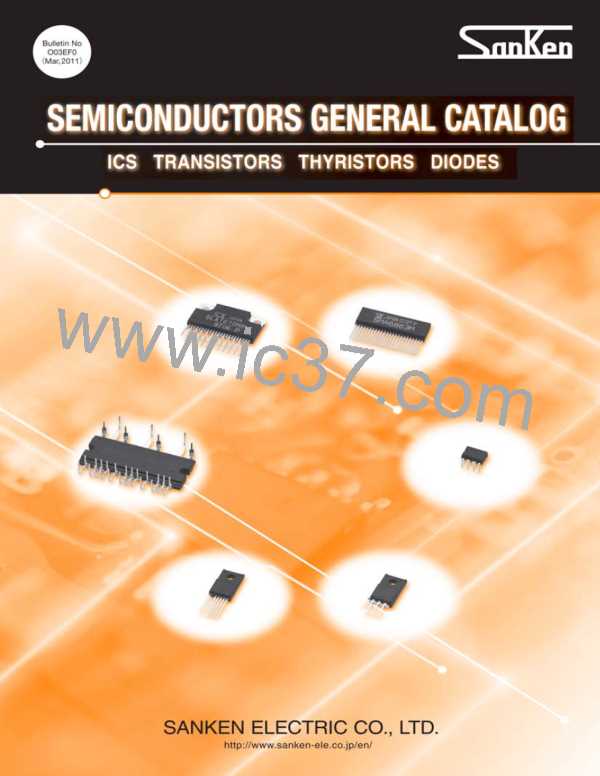1-1-3 DC/DC Converter ICs
Application Note
■ Heat Dissipation and Reliability
■ Mounting Torque
The reliability of an IC is highly dependent on its operating temperature.
Please be sure to apply silicone grease to the IC and to mount it to the
heatsink with a proper mounting torque.
SI-8000E
SI-8000JF
SI-8000S
Heatsink design should pay particular attention to ensuring sufficient heat
dissipation capacity.
SI-8000TFE
SI-8000HFE
SI-8000FFE
SI-8000Y
0.588 to 0.686[N•m] (6.0 to 7.0[kgf•cm])
In addition, please take into account the air convection in operation.
The reliability of discrete components such as capacitors and coils is
closely related to temperature. A high operating temperature may reduce
the service life. Exceeding the allowable temperature may burn the coils or
damage capacitors. It is important to make sure that the temperature of
output smoothing coils and input/output capacitors do not exceed their
allowable levels during operation. With an adequate derating for the coils,
minimize heat emission as far as possible. (For discrete components, refer
to the individual user manuals.)
■ Recommended Silicone Grease
• Shin-Etsu Chemical Co., Ltd.: G746
• Momentive Performance Materials Inc.: YG-6260
• Dow Corning Toray Silicone Co., Ltd.: SC102
Please select proper silicone grease carefully since the oil in some grease
products may penetrate the device and result in an extremely short device
life.
■ Internal Power Dissipation
PD can be obtained from the following formula.
• For the device with built-in flywheel diode:
■ Others
100
ηχ
• Devices can not be operated in parallel connection aiming for a larger
current.
PD=VO•IO (
–1)
• Not applicable for the current boost or voltage step-up use.
• For the device with external flywheel diode:
100
ηχ
VO
VIN
PD=VO•IO (
–1)–VF•IO(1–
)
■ Rectifier Diodes for Power Supplies
To rectify the AC input using rectifier diodes in power supplies, please use
SANKEN rectifier diodes shown in the following list. (Please use a center-
tap or bridge configuration in using stand-alone type diodes.)
Efficiency ηχ depends on the input/output conditions. Please refer to
the efficiency characteristics of the devices. (Posted on the Web site.)
VO :
VIN:
Output voltage
Input voltage
Series Name
SAI Series
Diodes
IO
:
Output current
Efficiency(%)
SI-8000W Series
SI-8000JD Series
SI-8000TM Series
SI-8000SD Series
SPI-8000A Series
SI-8005Q Series
SI-8001FDE Series
SI-8001FDL Series
SI-8008HD Series
SI-8000E Series
SI-8000JF Series
SI-8000TFE Series
SI-8000GL Series
SI-8000S Series
SI-8100QL Series
SI-8000FFE Series
SI-8000HFE Series
SI-8000Y Series
SI-8205NHD Series
STA801M Series
SI-8400L Series
ηχ :
VF :
Diode forward voltage
SJPM-H4 (Surface-Mount Stand-Alone Type,
VRM=400V,Io=2.0A)
■ Thermal Design
FMM-22S,R (Center-tap Type,VRM=200V,IO=10 A)
AM01Z (Axial Type,VRM=200V,Io=1.0A)
The maximum junction temperature Tj(max) given in the Absolute Maximum
Ratings is specific to each product type and must be strictly observed.
Thus, thermal design must consider the maximum power dissipation
PD(max), which varies by the conditions of use, and the maximum ambient
temperature Ta(max).
RM10Z (Axial Type,VRM=200V,Io=1.5A)
RM4Z (Axial Type,VRM=200V,Io=3.0A)
To simplify thermal design, Ta-PD characteristic graphs are provided herein.
Please observe the following steps for heatsink design:
1. Obtain the maximum ambient temperature Ta(max).
FMM-22S,R (Center-tap Type,VRM=200 V,IO=10 A)
RM10Z (Axial Type,VRM=200V,Io=1.5A)
AM01Z (Axial Type,VRM=200V,Io=1.0A)
2. Obtain the maximum power dissipation PD(max).
3. Look for the intersection point on the Ta-PD characteristic graph and
determine the size of the heatsink.
AM01Z (Axial Type,VRM=200V,Io=1.0A)
SI-8500L Series
Although the heatsink size is now obtained, in actual applications, 10-to-
20% derating factor is generally introduced. Moreover, the heat dissipation
capacity of a heatsink highly depends on how it is mounted. Thus, it is
recommended to measure the heatsink and case temperature in the actual
operating environment.
Please refer to the Ta-PD characteristic graphs for respective product
types.
ICs
11

 ETC [ ETC ]
ETC [ ETC ]